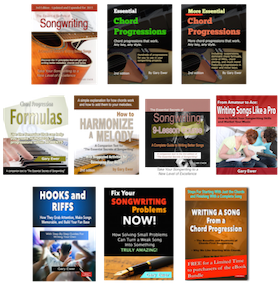Get “The Essential Secrets of Songwriting” Deluxe eBook Bundle, and take your songwriting to a new level of excellence. Includes “Writing a Song From a Chord Progression.”
When we say that you can write a song with nothing more than three chords, we’re usually talking about I-IV-V (like “La Bamba”), or perhaps I-ii-V. In C major, a I-IV-V progression is C-F-G, and a I-ii-V is C-Dm-G.
And it’s true, the number of songs that have been written based on those two progressions runs into the many thousands. If you add one more chord to that list (I-vi-ii-V, or I-vi-IV-V), you get a huge number more. Practically all doo-wop songs, and most other songs from the 50s and early 60s, would be based on 3- or 4-chord turnarounds.
Three-chord songs still happen, but don’t feel that you have to stick to the standard so-called 50s progression. The benefit to those early rock & roll progressions was that they were tonally strong (being based primarily on the circle of fifths), and suited the much simpler design of music in those days.
So how about some options for a new kind of 3- or 4-chord songs. If you’d like to experiment, try the following. They’re given in the key of C major, as well as in Roman numerals. Chords with a ‘6’ means that the 3rd of the chord should be in the bass. So I6 means a C chord with an E as the lowest note.
There’s a #IV7 in progression #4 of the 4-chord turnarounds. That’s a major chord based on the raised 4th degree of the scale. So in C major, #IV7 is F#7.
How you use these is up to you, of course. for the 3-chord turnarounds, you might play the first two chords for two beats each, and then hold the third one for 4. In any case, improvise and experiment with your own way to use them:
3-Chord Turnarounds
- C Eb Bb (I bIII bVII)
- C Dm Db7 (I ii bII7)
- C Eb Db (I bIII bII)
- C C/E F (I I6 IV)
- C Eb F (I bIII IV)
- C Ab7 G (I bVI7 V)
4-Chord Turnarounds
- C Am Bb F (I vi bVII IV)
- C F Ab Bb (I IV bVI bVII)
- C G/B F/A Fm (I V6 IV6 iv)
- G F#7 Bm7 Am7 (V #IV7 viim7 vi7)
- Em Am Bb F (iii vi bVII IV)
- Dm Em Am Bb (ii iii vi bVII)
What you’ll notice right away is that most of these are what I like to call “fragile” progressions, in the sense that they don’t make the key strongly obvious. That’s mainly due to the use of altered and non-diatonic chords (chords that don’t occur naturally in the given key)
You’ll find, therefore, that these progressions will be easier to use in verses and bridge sections. They’re refreshing because they stray away from the standard sound of typical I-IV-V kinds of progressions. At the same time, they’ll pick up a pleasant sense of predictability as you keep repeating them through your song.
Creating Your Own
If you want to try creating your own 3- or 4-chord turnarounds, the only thing you’ll want to check is how the last chord of you progression moves back to the first chord. You’ll usually want to avoid the “hiccup” that happens if the last chord has moved into some new key or key area.
 Written by Gary Ewer. Follow Gary on Twitter.
Written by Gary Ewer. Follow Gary on Twitter.
 Get “The Essential Secrets of Songwriting”. It’s being used by thousands of songwriters to improve their technique and become better, more prolific writers. To see today’s deal, visit the online store.
Get “The Essential Secrets of Songwriting”. It’s being used by thousands of songwriters to improve their technique and become better, more prolific writers. To see today’s deal, visit the online store.










